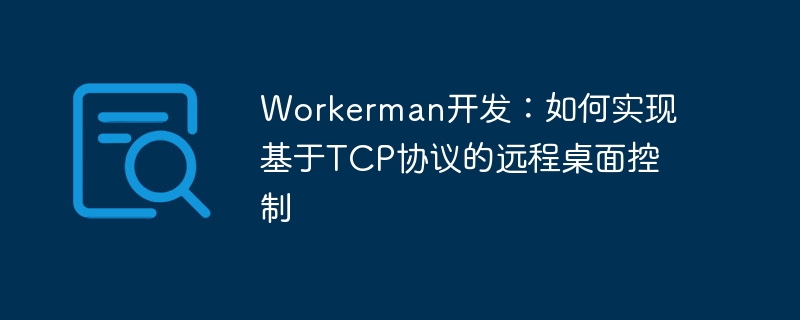

Workerman Development: How to implement remote desktop control based on TCP protocol
Introduction:
Remote desktop control is a common technology that allows users to Network remote control of a desktop interface on a computer. Remote desktop control based on TCP protocol is an efficient and stable method. This article will introduce how to use Workerman to develop remote desktop control based on TCP protocol and provide specific code examples.
1. What is Workerman?
Workerman is an open source high-performance PHP socket server framework that enables PHP developers to develop high-performance TCP/UDP/UnixSocket applications just like developing Node.js. Compared with traditional PHP servers, Workerman uses non-blocking IO and asynchronous event-driven models to support large-scale concurrent connections.
2. The principle of remote desktop control
Remote desktop control based on TCP protocol mainly includes two parts: server and client. The server is responsible for receiving the client's connection request and sending the received desktop interface information to the client. The client is responsible for connecting to the server and rendering and displaying the received desktop interface information. The specific workflow is as follows:
3. Use Workerman to realize remote desktop control
Server-side code example:
<?php
require_once __DIR__ . '/vendor/autoload.php';
use WorkermanWorker;
$desktop_worker = new Worker('tcp://0.0.0.0:5678');
$desktop_worker->onConnect = function ($connection) {
echo "Client connected
";
};
$desktop_worker->onMessage = function ($connection, $data) {
// TODO: 处理桌面界面信息
$connection->send($desktop_info);
};
$desktop_worker->onClose = function ($connection) {
echo "Client closed
";
};
Worker::runAll();Client-side code Example:
<?php
require_once __DIR__ . '/vendor/autoload.php';
use WorkermanWorker;
$desktop_client = new Worker();
$desktop_client->onConnect = function ($connection) {
echo "Connected to server
";
};
$desktop_client->onMessage = function ($connection, $data) {
// TODO: 渲染桌面界面
};
$desktop_client->onClose = function ($connection) {
echo "Server closed
";
};
$desktop_client->connect('tcp://127.0.0.1:5678');
Worker::runAll(); IV. Summary
This article introduces how to use Workerman to develop remote desktop control based on TCP protocol, and provides specific code examples. By using Workerman, we can implement remote desktop control functions efficiently and stably, providing users with a better experience. If you want to learn more about the application and development of Workerman, you can refer to its official documentation and pitfall guide.
The above is the detailed content of Workerman development: How to implement remote desktop control based on TCP protocol. For more information, please follow other related articles on the PHP Chinese website!




